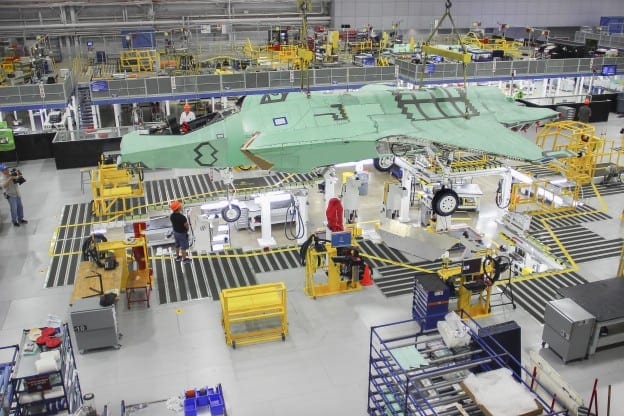
Norway’s first F-35A, called AM-1, is in production at the Lockheed Martin Fort Worth, Texas assembly plant. Photo: Lockheed Martin.
The Defense Department and Lockheed Martin expect to field a modernized, upgraded version of the F-35 Joint Strike Fighter’s Automated Logistics Information System (ALIS) by next fall, service and industry officials told lawmakers Nov. 13.
Testifying before a joint session of the House Armed Services Readiness and Tactical Air and Land Subcommittees, new F-35 Program Executive Officer Air Force Lt. Gen. Eric Fick said the Joint Program Office (JPO) and prime contractor Lockheed Martin expect to make “significant progress” on the notoriously cumbersome ALIS system by September 2020.
“We’re working that transition literally as we speak,” Fick said.
The company and the Air Force have worked to bring incremental upgrades to ALIS over the past year through several lines of effort, which were confirmed at the Air Force Association’s Air, Space and Cyber Conference earlier this year.
“We’re working … to coalesce those efforts into a single, new version of ALIS marching forward that leverages an underlying data architecture that’s expandable, with an expanding fleet in ways that the current ALIS isn’t,” Fick said. The JPO is working with the Air Force’s Kessel Run software development office – which has taken the lead on the “Mad Hatter” effort to build apps to improve ALIS workflow – as well as the Air Force’s 309th Software Squadron at Hill AFB, Utah, to field the new ALIS on schedule.
“The intent is to do it within existing program funds, but we have not finished our assessment as to whether additional funds will be needed,” Fick said.
Industry and department officials plan to field ALIS 3.5 by the end of calendar year 2019, said Greg Ulmer, Lockheed Martin’s F-35 vice president and general manager at the hearing.
An updated ALIS was just one of several requirements needed to improve the F-35’s much-maligned sustainment issues, lawmakers and government officials both said Wednesday.

A U.S. Marine Corps F35 aboard the U.S.S. America. Photo: U.S. Marine Corps, Lance Cpl Juan Anaya, Defense Visual Information Distribution Service.
“For too many years, sustainment has taken a backseat,” said Diana Maurer, director of defense capabilities and management at the U.S. Government Accountability Office (GAO), and a panelist at Wednesday’s hearing.
“While in recent years, this has changed for the better… let there be no doubt, the program is trying to dig itself out of a big hole,” she said in her opening remarks. “Many important plans, agreements and details on how to supply and maintain the F-35 were not worked out before the Marines, Air Force, Navy and international partners began using the aircraft. As a result, we have a very capable, very expensive system that’s not flying nearly as often as planned.”
The GAO released a new report Wednesday to coincide with the hearing, titled, F-35 AIRCRAFT SUSTAINMENT:DOD Faces Challenges in Sustaining a Growing Fleet.” In it, the agency identified a variety of issues that will continue to impact the aircraft’s sustainability, including supply parts shortage and an overall lack of critical planning, as well as ALIS challenges.
“If ALIS doesn’t work, the F-35 doesn’t work and ALIS has been struggling for years,” Maurer said, adding that on the supply chain side, there are not enough spare parts to go around and F-35 parts are breaking more often than expected. Meanwhile, suppliers are taking twice as long as expected to replace those parts, and critical depot repairs won’t be completed until 2024, she noted.
“During the last fiscal year, F-35s were on average able to perform one of their main intentional missions less than two-thirds of the time, and all missions only about one-third of the time,” Maurer said. The GAO made 21 recommendations for the program, which were largely agreed to by the Defense Department, she said.
This article was originally published in Defense Daily, a sister publication to Avionics International. To view the full version, click here>>